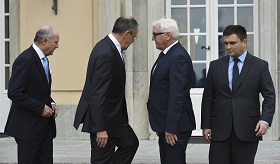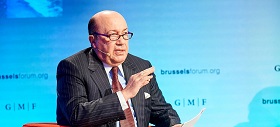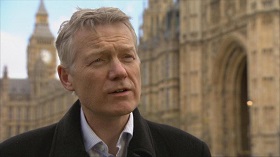The appointment of Ambassador Kurt Volker as special envoy for Ukraine signals a renewed interest in Ukraine-related diplomacy in Washington. It is a good time to revisit the troubled Minsk diplomatic process, and to contemplate possible steps toward resolving the conflict necessitates the need to reflect upon on what has gone wrong over the past two years.
After months of fierce debate and an inability for the involved states to reach a resolution, Minsk diplomacy ran from the fall of 2014 to February 2015. It established a diplomatic framework for ending the violence and achieving a political settlement. According to “Minsk,” which is shorthand for multiple agreements, the first step was a ceasefire in the Donbas. Then, elections were to be prepared under ODIHR supervision and the border was to be sealed as complimentary processes, thus restoring Ukrainian sovereignty. All of this was supposed to occur by December 2015. This deadline has long passed, and Minsk not been implemented.
A new deadline should be set. It cannot be too distant or too immediate. A few months is too short, a few years too long. Instead of a single deadline, it may be better to disaggregate the final deadline, beginning with the ceasefire and continuing with the moveable pieces of the political process. It would also make sense to combine the deadline with incentives for compliance and penalties for failing to adhere to it. If there is no penalty for missing the deadline, as was the case with Minsk, the forces that serve the status quo will conspire to ensure that Minsk II “fails” in the same way Minsk did, as far as its December 2015 deadline was concerned. The past two years demonstrate that a resolution to the crisis is immensely difficult. Only with concentrated and sustained effort will any progress be made.
The appointment of Ambassador Kurt Volker as special envoy for Ukraine signals a renewed interest in Ukraine-related diplomacy in Washington. It is a good time to revisit the troubled Minsk diplomatic process, and to contemplate possible steps toward resolving the conflict necessitates the need to reflect upon on what has gone wrong over the past two years.
An international collision over Ukraine began in early 2014, driven by incompatible aspirations on the part of the involved countries. Ukraine sought to protect its sovereignty and to draw closer to the EU and NATO. Russia was trying to halt the eastward spread of Western security structures and to retain political leverage over Ukraine. France and Germany were eager to see European security restored and to contain what they perceived as Russian aggression. As with France and Germany, the U.S. construed Russian activities in Ukraine as a violation of the liberal international order and a threat to European security. Joint EU/U.S. sanctions were imposed to redress this violation. The Western powers agreed with Ukraine that sovereignty was at the core of the crisis, whereas Russia put stability and its own security at the center of the crisis.
After months of fierce debate and an inability for the involved states to reach a resolution, Minsk diplomacy ran from the fall of 2014 to February 2015. It established a diplomatic framework for ending the violence and achieving a political settlement. According to “Minsk,” which is shorthand for multiple agreements, the first step was a ceasefire in the Donbas. Then, elections were to be prepared under ODIHR supervision and the border was to be sealed as complimentary processes, thus restoring Ukrainian sovereignty. All of this was supposed to occur by December 2015.
This deadline has long passed, and Minsk not been implemented. It may be that Minsk has satisfied the minimum requirements for each of the interested parties. It has minimized the fighting in the Donbas, granting not full sovereignty for Ukraine but a degree of sovereignty comparable to what Ukraine possessed in autumn 2014. For France and Germany, European security in the East is still an elusive ideal; nevertheless, the fighting that had been unbridled in early 2014 has been (imperfectly) contained. Likewise, for Washington, Minsk’s value resides in having forestalled the worst-case scenarios, such as the conflict spreading throughout Europe. Fashioning Minsk made Moscow integral to Ukraine-related diplomacy. Ukraine in 2017 is very far from joining NATO, and no closer from joining the EU. The decentralization to which Kyiv committed itself in Minsk promises Russian political leverage in the future.
Minsk has not been useless. Yet the long-term failure to implement Minsk is debilitating for Ukraine, Russia, Europe and the U.S. The perpetuation of war on Ukrainian soil is a terrible burden on the Ukrainian economy and politics. Turmoil in the Donbas means that Europe must contend with security problems in the East in addition to the threats it faces in the South. NATO’s eastern flank is a new and costly budgetary priority. U.S.-Russian relations have been poisoned by the protracted conflict over Ukraine, and this poison risks becoming the prelude to direct conflict between Russia and the U.S., most likely in the event of an accident in the vicinity of the Baltic states or Kaliningrad oblast’. If Minsk ever fails definitively, it will have global rather than regional consequences. Minsk itself has suffered from three problems since 2014: ceasefire, sequence and deadline.
The ceasefire never took root. The line of conflict has witnessed violations from both sides, with the majority coming from the separatists, according to OSCE reports. Without a ceasefire, each side has had an incentive not to move forward with the other provisions laid out in Minsk, the demilitarization of the Donbas, or a political settlement.
The diplomacy around “February Minsk” — February 2015 — entailed a meeting of Presidents Putin, Poroshenko, Hollande, and Chancellor Merkel. Their meeting went on late into the night. The result was a poorly written and poorly conceptualized document that has yielded two irreconcilable notions of sequence. The “Russian notion” presumes a ceasefire followed by a political settlement, after which the border will be sealed. The “Ukrainian notion” also begins with a ceasefire, but it posits a sealed border as the precondition for a political settlement. Since 2015, this disagreement over Minsk sequencing has been intractable, and both sides can point to the same clauses in Minsk in support of their preferred interpretation.
Finally, the December 2015 deadline embedded in Minsk was too ambitious, and once it passed there was decreasing pressure on all sides to risk diplomatic progress. To embark on a political settlement is an enormous risk for Kyiv, and decentralization as stipulated in Minsk is politically unpopular across Ukraine. The separatists will presumably have to give up power peacefully and trust, after two years of fighting, that Kyiv will grant them the amnesty decreed in Minsk. To seal the border is a risk for Russia, for it will shift control of the entire situation back to Kyiv. A dysfunctional status quo can appear preferable to the hard task of acting on this status quo.
Diplomatic initiative should be invested immediately in reformulating Minsk. This initiative should begin below and progress to the ministerial level. Its goal should be the preparation of points on which the Presidents of Ukraine, Russia and France, as well as the German Chancellor, can agree upon. Whether or not the “Normandy format” (Ukraine-Russia-France-Germany) is preserved, the American president should participate in an eventual meeting at which a new Minsk would be ratified and shared with the public. It is crucial that Ukraine, Russia, Germany, France and the United States all be committed to this recalibrated Minsk agreement or Minsk II.
Minsk II will need to lay out a rigorous ceasefire plan. In a chaotic area filled with paramilitary units, stopping the fighting will not be easy. Many local actors profit from the current situation, and it will take a powerful display of outside force to reach a genuine ceasefire. The UN could be a vehicle for the provision of peacekeeping troops who would be granted the necessary authority and firepower to impose a lasting peace and to ensure that the silenced weapons are withdrawn far behind the line of contact.
A credible ceasefire is the precondition for a political process, and Minsk II should establish a lucid sequence for this political process. The elements of the process are all present in Minsk: amnesty for the separatists, elections under Ukrainian law and ODIHR supervision, sealing the border, special status for the Donbas — i.e. those areas currently referred to as the DNR and the LNR. Rather than working through the thorny question of sequence at the end of the diplomatic process, at the presidential level, this is should be elaborated before the Presidents and Chancellor meet. Once the involved parties agree on a sequence, their agreement must be captured in clear prose and translated into a working document that is not susceptible to multiple interpretations. This document could then be endorsed at the highest levels.
A new deadline should be set. It cannot be too distant or too immediate. A few months is too short, a few years too long. Instead of a single deadline, it may be better to disaggregate the final deadline, beginning with the ceasefire and continuing with the moveable pieces of the political process. It would also make sense to combine the deadline with incentives for compliance and penalties for failing to adhere to it. If there is no penalty for missing the deadline, as was the case with Minsk, the forces that serve the status quo will conspire to ensure that Minsk II “fails” in the same way Minsk did, as far as its December 2015 deadline was concerned. The past two years demonstrate that a resolution to the crisis is immensely difficult. Only with concentrated and sustained effort will any progress be made.
Minsk is not simply a Russia-U.S. problem. Indeed, the U.S. was not a signatory to Minsk, and Washington might be tempted to declare Minsk a European diplomatic process, for Europeans to manage as best they can. In addition, Russia-U.S. relations have not improved since the election of Donald Trump, and the domestic political climate, in the U.S., is not conducive to creative diplomacy in Europe or anywhere else: a cloud of scandal, intimately tied to Russia, hangs over the country. It would, however, be shortsighted to sacrifice diplomacy for scandal and to allow the churn of domestic politics to set the goals of foreign policy. Unresolved, the conflict over Ukraine will continue to pull Washington and Moscow toward conflict. A diplomatic resolution, which can only be realized if Minsk is revisited and redesigned, is in the national interest of the United States, of Ukraine, of Russia and of Europe.
At several points in the Cold War diplomats found ways of moving closer to order and stability, against the odds. It is in that spirit that a new wave of multilateral diplomacy should be attempted today.







